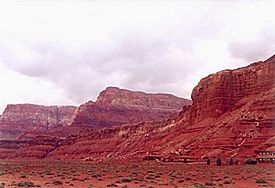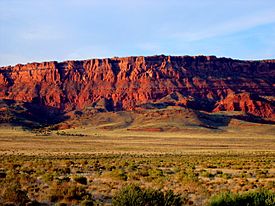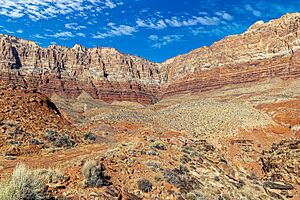Vermilion Cliffs facts for kids

The Vermilion Cliffs are amazing red rock formations. They are found in northern Arizona and southern Utah in the southwestern United States. Imagine a giant staircase made of rock! The Vermilion Cliffs are like the second big step in this "Grand Staircase" of the Colorado Plateau. They stretch for a long way, starting near Page, Arizona.
These beautiful cliffs are very special. Over 112,500 acres of this area became the Paria Canyon-Vermilion Cliffs Wilderness in 1984. Even more land was protected as the Vermilion Cliffs National Monument in 2000. This helps keep the natural beauty safe for everyone.
Contents
Discovering the Vermilion Cliffs
What Makes the Cliffs Red?
The Vermilion Cliffs get their name from their bright, reddish-orange color. This color comes from the rocks they are made of. These rocks are mostly strong red sandstone. Geologists call these the Moenave and Kayenta Formations.
These rocks formed from ancient silt and desert sand dunes. Over millions of years, these materials piled up. Then, natural cements like carbonates seeped in and hardened them. The intense red color comes from tiny bits of iron oxide, which is like rust. Other minerals, such as bluish manganese, also add to their unique look. The cliffs are part of the larger Colorado Plateau Province.
A Journey Through History
The Vermilion Cliffs were once a very important pathway. Settlers used this route to travel between Utah and Arizona in the 1800s. A brave pioneer and missionary named Jacob Hamblin explored this area. He even started a ranch at the base of the cliffs in House Rock Valley.
Today, you can drive along U.S. Highway 89A. This road mostly follows the old wagon trail that settlers used. It goes past the cliffs through House Rock Valley. Then it climbs up the Kaibab Plateau towards Jacob Lake.
Many famous places are found near these cliffs. These include Lee's Ferry, Glen Canyon and the Glen Canyon National Recreation Area. You can also find The Wave and Coyote Buttes here. These spots are known for their amazing rock formations.
Exploring the Landscape
You can see the reddish, or vermilion-colored, cliffs in many places. They are visible along U.S. Highway 89A near Navajo Bridge. You can also spot them from U.S. Highway 89 close to Bitter Springs. Highway 89A runs right next to the Vermilion Cliffs for much of its path. This is between Jacob Lake and Marble Canyon. It offers incredible views of the towering cliffs.
Amazing Desert Flowers
After a good winter rain, the valley between Highway 89 and the Vermilion Cliffs transforms. In the spring, it becomes a beautiful carpet of desert mallow and other colorful wildflowers. It's a truly stunning sight to see the desert bloom.
See also
 In Spanish: Acantilados Vermilion para niños
In Spanish: Acantilados Vermilion para niños
- Vermilion Cliffs National Monument
- Paria Canyon-Vermilion Cliffs Wilderness
- California condor – Vermilion Cliffs are a release site for these amazing birds.




